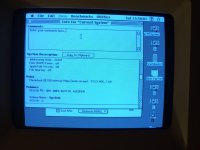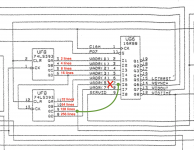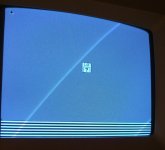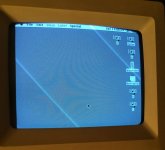apm
Well-known member
Since I guess one compact Mac resolution hacking project isn't enough, I found a relatively easy hack to get extra vertical resolution on the SE/30 with no analog mods at all:

As the screen shot shows, this Mac is running with internal video at 512x406 resolution -- 64 more lines than standard.
Making this modification requires cutting one connection on the logic board, making one new connection, and changing six bytes in the UK6 video DeclROM. Here's the wiring mod:

I'll save the details for a following post, but in short, pin 7 of UG6 needs to be lifted from the board, so that instead of attaching to pin 10 of UF8, it attaches to pin 9 of UF8.
This needs to be done on the UG6 side because the signal from UF8 also goes elsewhere on the board. I did this by unsoldering and then socketing UG6, while bending pin 7 outward so it doesn't go into the socket. But now that I know this mod works, it would be just as easy to clip the leg on UG6 just above the board and solder a wire to the remaining stub coming from the chip.
Making this change causes the screen to scan 64 more lines than before (406 lines rather than 342), after which the screen will look like this:

The Simasimac stripes on the bottom are because the Mac doesn't yet know about the extra video resolution so it doesn't initialise that part of VRAM. To get it to use the space, two bytes in Video DeclROM UK6 need to be changed: locations 0x6f3 and 0x1047 both change from value "0x56" to "0x96" -- these both in some way define the vertical resolution. Then the 4-byte checksum at the end of the ROM has to change. Fortunately, UK6 is already socketed and easily replaced.
To start with, the picture will be too tall:

I changed the height to be just small enough to fit on the CRT, and put the horizontal width down quite low to keep the pixels roughly square since it's a weird aspect ratio. The result is what you see in the first image.
The catch? The refresh rate drops to 51Hz which is pretty noticeably flickery! I'm not sure I'd want to spend long hours looking at it. But still, it's almost 20% more screen real estate than before, and more vertical resolution than the Portable.

As the screen shot shows, this Mac is running with internal video at 512x406 resolution -- 64 more lines than standard.
Making this modification requires cutting one connection on the logic board, making one new connection, and changing six bytes in the UK6 video DeclROM. Here's the wiring mod:

I'll save the details for a following post, but in short, pin 7 of UG6 needs to be lifted from the board, so that instead of attaching to pin 10 of UF8, it attaches to pin 9 of UF8.
This needs to be done on the UG6 side because the signal from UF8 also goes elsewhere on the board. I did this by unsoldering and then socketing UG6, while bending pin 7 outward so it doesn't go into the socket. But now that I know this mod works, it would be just as easy to clip the leg on UG6 just above the board and solder a wire to the remaining stub coming from the chip.
Making this change causes the screen to scan 64 more lines than before (406 lines rather than 342), after which the screen will look like this:

The Simasimac stripes on the bottom are because the Mac doesn't yet know about the extra video resolution so it doesn't initialise that part of VRAM. To get it to use the space, two bytes in Video DeclROM UK6 need to be changed: locations 0x6f3 and 0x1047 both change from value "0x56" to "0x96" -- these both in some way define the vertical resolution. Then the 4-byte checksum at the end of the ROM has to change. Fortunately, UK6 is already socketed and easily replaced.
To start with, the picture will be too tall:

I changed the height to be just small enough to fit on the CRT, and put the horizontal width down quite low to keep the pixels roughly square since it's a weird aspect ratio. The result is what you see in the first image.
The catch? The refresh rate drops to 51Hz which is pretty noticeably flickery! I'm not sure I'd want to spend long hours looking at it. But still, it's almost 20% more screen real estate than before, and more vertical resolution than the Portable.
